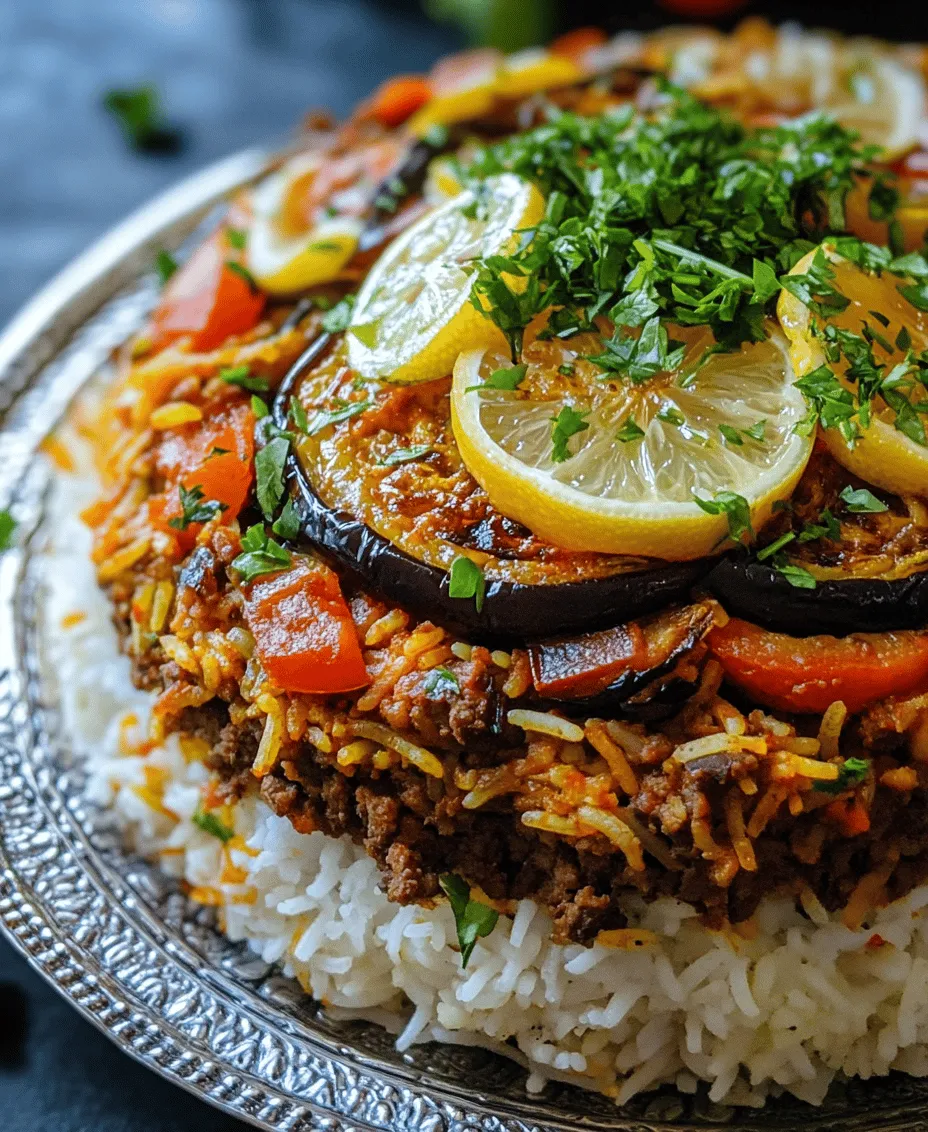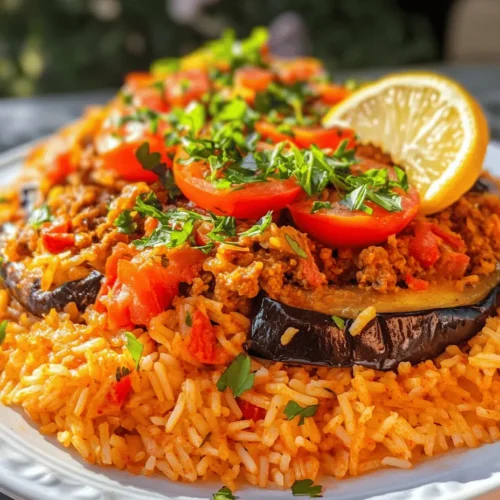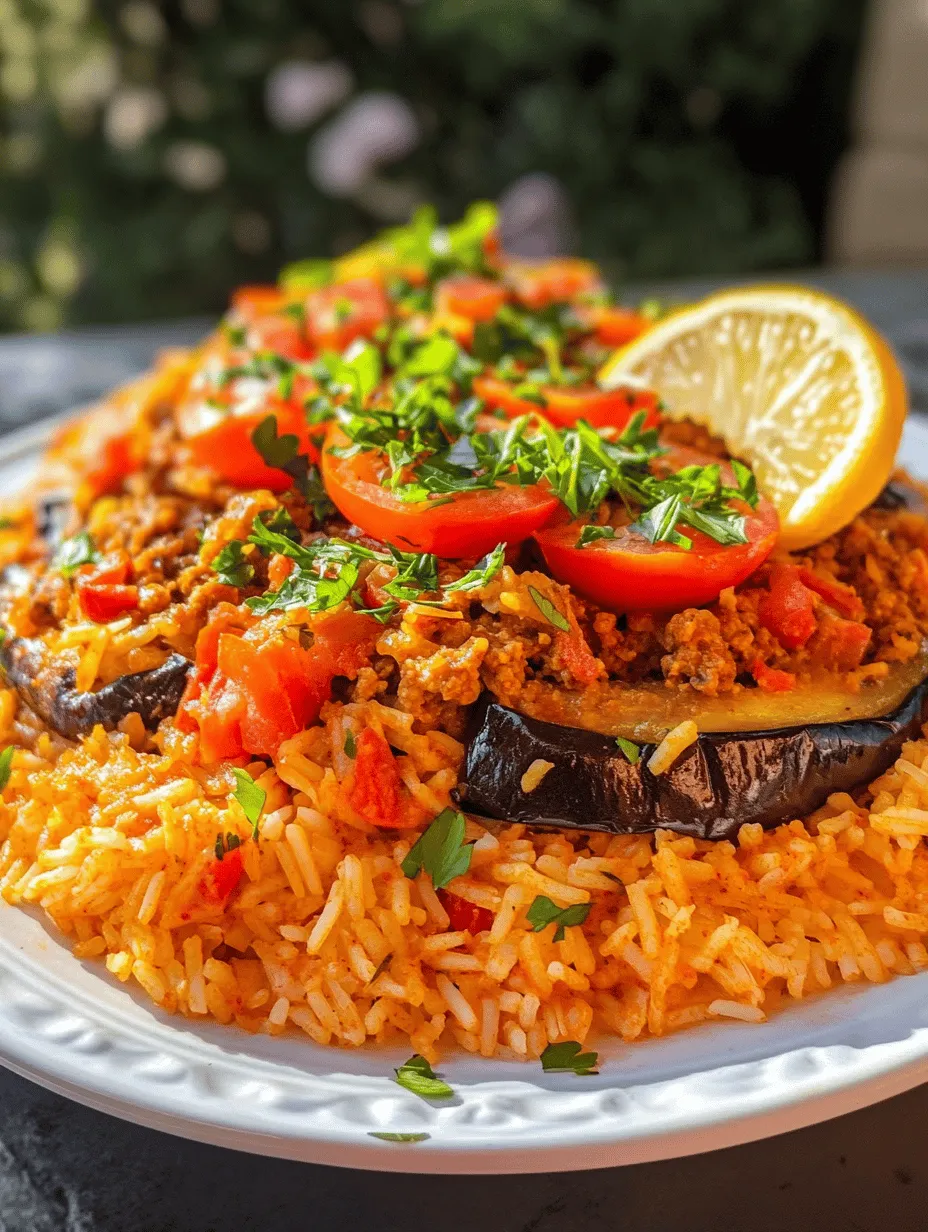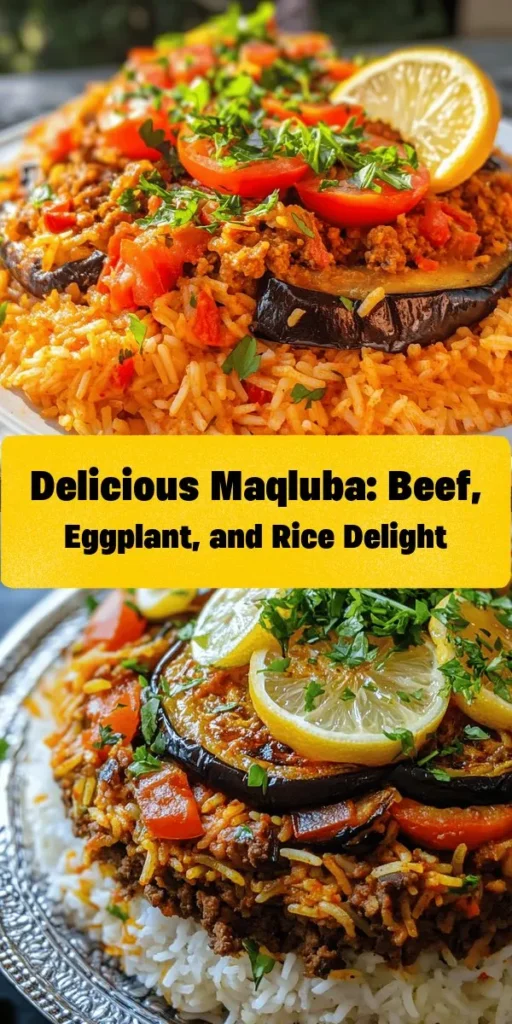Introduction
Maqluba, a traditional Middle Eastern dish, is a culinary marvel that captivates both the palate and the eye. Its name, which translates to “upside-down” in Arabic, perfectly encapsulates the unique cooking method that defines this dish. With its layers of rice, tender meat, and vibrant vegetables, Maqluba is not just a meal; it is a celebration of flavors and textures that come together harmoniously. The upside-down cooking technique not only adds a visual flair but also enhances the melding of spices and ingredients, creating a dish that is as aromatic as it is delicious.
The appeal of Maqluba lies in its rich combination of flavors, particularly the succulent beef, earthy eggplant, and an array of spices that bring warmth and depth to each bite. This dish is often prepared for special occasions and family gatherings, reflecting the communal spirit of Middle Eastern dining. When you serve Maqluba, you unveil a stunning presentation that invites everyone to dig in, making it a centerpiece for any meal.
The Cultural Significance of Maqluba
Maqluba’s origins can be traced back to the Levant region, specifically Palestine, Jordan, and Syria, where it has been a staple in households for generations. The dish embodies the essence of Middle Eastern cuisine, which emphasizes the use of fresh ingredients, aromatic spices, and the importance of family and hospitality. Traditionally, Maqluba is prepared for large gatherings and celebrations, symbolizing unity and sharing. The act of flipping the pot upside down to reveal the beautifully layered dish is a ritual that adds to the excitement of dining together.
In many families, Maqluba is more than just food; it is a vessel for storytelling and bonding. It is often prepared on special occasions like weddings, holidays, or simply for a Sunday family dinner. The communal aspect of sharing this dish fosters connections, as everyone gathers around the table to enjoy a meal that has been lovingly prepared. Each family may have its own version of Maqluba, passed down through generations, with variations in ingredients and cooking techniques that reflect regional influences and personal preferences.
As you embark on the journey of making Maqluba, you’re not just following a recipe; you’re participating in a rich cultural tradition that honors the flavors of the Middle East and the joy of togetherness.
Ingredients Breakdown
To create a flavorful Maqluba, it’s essential to use high-quality ingredients that will work together to produce a satisfying dish. Below is a breakdown of the key ingredients used in this recipe:
Basmati Rice
Basmati rice is a crucial component of Maqluba, known for its long grains and fragrant aroma. Before cooking, it’s important to rinse the rice thoroughly to remove excess starch, which can lead to clumping. Soaking the rice for 30 minutes prior to cooking helps achieve the perfect fluffy texture. This step allows the grains to absorb water, ensuring they cook evenly and don’t become mushy during the process.
Ground Beef
Ground beef adds a hearty element to the dish, contributing richness and flavor. While beef is the traditional choice, you can easily substitute it with ground lamb or chicken for a different taste experience. For a vegetarian option, consider using chickpeas or lentils, which will provide protein and a satisfying texture while allowing the dish to retain its essence.
Eggplant
Eggplant is a staple ingredient in Maqluba, known for its ability to absorb flavors and provide a creamy texture. To prepare the eggplant, it’s important to slice it and sprinkle salt over the pieces, allowing them to sit for about 30 minutes. This process draws out excess moisture and bitterness, ensuring the eggplant cooks to a perfect golden-brown color. Afterward, rinse and pat the slices dry before cooking.
Spices
The spices used in Maqluba are pivotal to its aromatic profile. A combination of cumin, cinnamon, and allspice creates a warm, fragrant base that infuses the dish with character. Cumin adds a nutty flavor, cinnamon offers warmth, and allspice contributes a hint of sweetness. These spices not only enhance the taste but also reflect the culinary heritage of the region, showcasing the rich tapestry of flavors found in Middle Eastern cuisine.
Broth vs. Water
When preparing Maqluba, the choice between using broth or water can significantly impact the dish’s depth of flavor. Using beef or vegetable broth enhances the richness and complexity, while water can result in a milder taste. For the best results, opt for homemade broth if possible, as it adds a layer of authenticity and elevates the overall dish.
Step-by-Step Preparation Process
Now that we’ve gathered our ingredients, let’s dive into the preparation process, starting with the eggplant, which is a key player in this recipe.
Preparing the Eggplant
To prepare the eggplant, begin by slicing it into rounds or half-moons, depending on your preference. Generously sprinkle salt over the slices and allow them to rest in a colander for about 30 minutes. This step is crucial as it helps extract excess moisture and bitterness from the eggplant. After the resting period, rinse the eggplant slices thoroughly under cold running water to remove the salt, and then pat them dry with paper towels. Removing moisture not only enhances the flavor but also ensures the eggplant becomes beautifully caramelized when cooked.
Cooking the Eggplant
To achieve the perfect golden-brown color and texture, heat a generous amount of oil in a large skillet over medium-high heat. Once the oil is hot, carefully add the eggplant slices in batches, making sure not to overcrowd the pan. Fry the eggplant until it turns golden brown on both sides, which usually takes about 3 to 4 minutes per side. Once cooked, transfer the eggplant to a paper towel-lined plate to absorb excess oil. This step enhances the flavor and sets the stage for the next layers of the Maqluba.
With the eggplant prepared, we can move on to the next steps that will bring this stunning dish to life. The cooking process will involve layering the ingredients, sautéing the ground beef, and finally assembling everything in the pot for the signature upside-down presentation. Each step builds upon the last, ensuring that all flavors meld beautifully together for a meal that is not only visually striking but also rich in taste.
Stay tuned for the continuation of this delicious Maqluba recipe, where we will explore the final steps of assembly and cooking, leading to the grand reveal of this Middle Eastern masterpiece.

Sautéing the Aromatics
To create a flavorful base for your Maqluba, proper sautéing of onions and garlic is essential. Start by heating a generous amount of olive oil in a large, heavy-bottomed pot over medium heat. Once the oil is shimmering, add finely chopped onions. Sauté them until they become translucent and fragrant, about 5-7 minutes. Next, add minced garlic, stirring continuously to avoid burning. The key is to let the garlic cook just until it becomes fragrant, approximately 30 seconds to 1 minute. This step is crucial as it builds the foundational flavors that will infuse the entire dish.
Browning the Beef
Once your aromatics are ready, it’s time to add the beef. Use cubed beef that has been seasoned with salt, pepper, and a sprinkle of ground cumin to enhance the depth of flavor. Increase the heat to medium-high and add the beef to the pot, browning it on all sides. This browning process is not just for color; it creates a rich, caramelized crust that will add complexity to your Maqluba. Allow the beef to cook for about 8-10 minutes, turning occasionally to ensure even browning. Once the beef is browned, you can deglaze the pot with a splash of water or broth, scraping up any flavorful brown bits from the bottom.
Layering the Ingredients
The layering of ingredients is one of the most critical steps in making Maqluba, as it affects both the cooking process and the final presentation. Start by layering the base with the browned beef, distributing it evenly. Next, add a layer of sliced eggplant. It’s essential to salt the eggplant slices beforehand to draw out excess moisture and bitterness; rinse and pat them dry before layering. Follow the eggplant with a layer of rice, spreading it evenly over the vegetables. Repeat this layering process until all ingredients are used, finishing with a layer of rice on top. Ensure that the layers are packed tightly, as this will help the dish maintain its shape during the cooking process.
Adding Tomatoes and Broth
After layering your ingredients, it’s time to add tomatoes and broth. Pour in diced tomatoes, which will add acidity and moisture to the dish. Then, pour in enough beef broth (or water) to cover the rice by about an inch. This liquid is crucial for cooking the rice and infusing flavors throughout the dish. If you desire, add a few whole cloves or cardamom pods to the broth for extra aroma. Bring the mixture to a gentle simmer before covering the pot with a tight-fitting lid.
Cooking the Maqluba
Cooking Maqluba requires careful attention to time and temperature. Once the pot has reached a simmer, reduce the heat to low, allowing the dish to cook gently for about 30-40 minutes. It’s essential not to lift the lid during this time, as steam is needed to cook the rice properly. After about 30 minutes, check the rice for doneness. If it still feels slightly firm, give it an additional 5-10 minutes. The final result should be tender rice that has absorbed all the flavors of the beef and vegetables.
Unmolding Techniques
Once your Maqluba has finished cooking, allow it to rest for about 10 minutes off the heat. This resting time helps the dish set, making it easier to unmold. To invert the Maqluba, place a large serving platter over the pot. With a steady hand, carefully flip the pot over so that the Maqluba slides onto the platter. Tap the bottom of the pot gently to encourage the dish to release. If done correctly, you should have a perfectly inverted Maqluba, showcasing the beautiful layers of beef, eggplant, and rice.
Garnishing and Serving Suggestions
Garnishing your Maqluba can elevate its presentation and flavor. Consider sprinkling freshly chopped parsley or cilantro on top for a pop of color. Toasted pine nuts or slivered almonds can add a delightful crunch, while a drizzle of tahini sauce or a side of yogurt can introduce a creamy contrast. Serve your Maqluba with a simple side salad, perhaps a Fattoush or Tabbouleh, to balance the richness of the dish. For an authentic experience, you might also include pickled vegetables on the side, enhancing the overall flavor profile.
Tips for Perfecting Your Maqluba
When making Maqluba, there are several common pitfalls to be aware of. One of the most significant is using too much liquid, which can lead to mushy rice. Always check the rice for doneness before adding more broth. Adjusting seasoning is also vital; taste as you go, especially after adding the broth. Remember that spices can vary greatly in potency, so start with a smaller amount and build up to your desired flavor.
For those wanting to experiment, there are numerous variations of Maqluba to consider. You can substitute the beef with chicken or lamb and the eggplant with other vegetables like cauliflower or zucchini. Each region in the Middle East has its take on Maqluba, so feel free to explore these regional differences and ingredient substitutes to make the dish your own.
Nutritional Benefits of Maqluba
Maqluba is not just a delicious dish; it is also packed with nutritional benefits. The primary ingredients—beef, eggplant, and rice—provide a balanced mix of protein, carbohydrates, and essential vitamins. Beef is an excellent source of protein and iron, while eggplant contributes fiber and antioxidants. The spices used, such as cumin and coriander, also have various health benefits, including anti-inflammatory properties and digestion support. The combination of protein, vegetables, and carbohydrates makes Maqluba a well-rounded meal that satisfies hunger and nourishes the body.
Conclusion
Maqluba is more than just a meal; it’s a dish steeped in cultural significance and tradition. The unique flavors and textures come together to create a culinary experience that reflects the heart of Middle Eastern cooking. We encourage you to try making Maqluba at home, not only to enjoy its delicious taste but also to share this beautiful dish with your loved ones. Cooking is a joyful act, and Maqluba offers a wonderful opportunity to connect with family and friends around the dinner table. Embrace the magic of Maqluba, and savor every bite!



